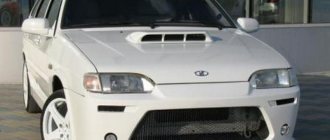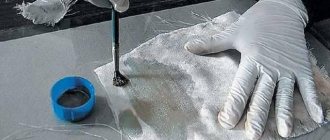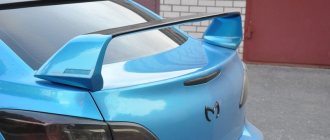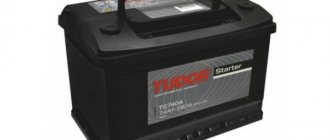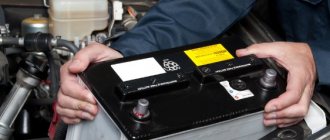Comments: one Published: 10/24/2017
Rating:
In the harsh conditions of our winters, one month of car operation can be equated to a year of summer driving. What suffers first of all from the famous sand-salt mixture of domestic utilities is the body of the car - its service life is significantly reduced, this equally applies to both foreign cars and domestically produced cars. Even high-quality anti-corrosion treatment carried out by the manufacturer before painting the body will not be able to reliably protect the metal from the effects of chemically active reagents that are present in any deicing agent. Even if the winter turns out to be snowless, temperature changes will still do their evil deed. It is worth worrying about the question of how to treat your car for the winter, since protective coatings will not only extend its life, but will also ensure trouble-free operation in the frosty season.
Car in winter
See also:
How to treat the underbody of a car with mastic
Paint protection
Perhaps it’s worth starting with the preparation and protection of one of the most important parts of the car - the paintwork of the body. In winter, large amounts of de-icing chemicals are applied to roads, which have a detrimental effect on paintwork. Contacts with road gravel, sand and ice have a negative impact on the safety of both the appearance of the car and the body itself. The car's paintwork begins to fade, becomes covered with a chemical coating, and a large number of chips and scratches form. But the worst thing is that pockets of corrosion appear on the body.
To protect the paintwork from chemicals and loss of appearance, there are special protective compounds. They are usually applied in a thin layer over the entire surface of the car and prevent contact of the paintwork with the environment. These products differ both in the complexity of application to the car body and in the duration of action. The simplest method of application is protective wax, but it also has the shortest service life. Any car enthusiast can apply wax without special training after washing the car in a warm and clean room. But you need to remember that the service life of protective wax is from one to several washes.
, and the application procedure will need to be repeated.
The second type of product is “ceramic” protective coatings
containing silicon compounds, which allows these products to provide a very high degree of body protection.
These compounds will last much longer than protective waxes. Their service life can range from several months to six months
.
But these compounds must be applied by a specially trained technician in a room equipped for these purposes.
How to treat a car body for the winter
How to protect your car body in winter?
Which of us prefers winter to other seasons? Cold, piercing wind, periodic ice - it’s difficult to fall in love with this. Especially if “this” lasts six months, and not a month or two as in Europe. Believe me, your favorite iron horse is also not particularly happy about the November slush or January frosts. The engine and gearbox are often forced to work at full capacity without normal warming up. Almost all types of batteries deteriorate and degrade due to cold weather. In winter it also affects the body. In this article we will share secrets for external protection of the iron horse during the season from October to March.
Tip #1. Touch up chips
Winter is a season when the temperature in the middle zone dances around zero degrees, and the air is humid to the limit. Moisture loves to get into any cracks in the coating. When it freezes, it expands and destroys the paint even more. And there the corrosion spots are just a stone's throw away. In November you had no significant comments about the appearance of your car, but by March you will count a dozen of them. That's why the first thing you need to do before the onset of cold weather is to eliminate scratches on the body.
However, it’s also not worth repainting every scratch. Wash your car thoroughly and visit a body repair specialist. There, your car will be carefully examined and those scratches that have reached the ground layer will be noted. These are the ones that should be dealt with first. Pay special attention to the wheel arch areas - small stones and sand constantly attack the paint in these places. In turn, scratches that did not reach the primer can be eliminated yourself using a tinting pencil.
At the MEKS auto repair shop, we did not skimp on equipment for the paint shop and on specialists who love their work. Read about it here or just come to us, we will show you everything.
Tip #2. Apply protection to the body.
When temperature changes occur, the paintwork is constantly under stress and becomes more fragile. That is why any pebble that flies into the body can turn into a chip of paint, although in the summer such a “meeting” would pass without consequences. But the stones are not the worst thing. The main pest for the body is salt. Moscow road workers are covering all horizontal surfaces in the city with a killer cocktail of table salt and calcium chloride. How to protect yourself from all this?
Wax. The most popular way of protection. The most actively sold additional service at any car wash. Small things attacking the body get stuck in the wax, but it will not protect against large stones. For typical urban operating conditions, wax is quite sufficient. Just remember that the wax coating will only survive two washes at most before you have to start all over again. But there are much more durable and powerful means.
Ceramics. You've probably heard the name “Ceramic Pro 9H”. The best friend of the owner of a brand new black Cayenne in winter is needed not only by lovers of external gloss, but also by all other car owners. Silicone-containing compounds are wax on steroids: they don’t wash off in the wash and resist external threats much better. You can ride for a whole year forgetting about salt and stones. There is one minus and it is known to everyone - the astronomical price (
Anti-gravel film. There are two types of such films - PVC and polyurethane. PVC film is scratched, becomes cloudy, turns yellow and is inexpensive. Polyurethane film is devoid of almost all the disadvantages of PVC. They say that the best polyurethane films protect not only from stones, salt and branches, but even from the consequences of minor accidents. And also from robberies, traffic police and failures in life. However, like ceramics, polyurethane will not please you with an affordable price tag.
Usually, only owners of premium cars bother with covering the car body with some kind of layer of protection. And in vain, because, for example, covering a car with wax is very inexpensive, but the effect, as they say, is obvious. Ceramics can also be found quite inexpensively; for example, we often use H9 from the Japanese Soft99. Well, it’s the same with film; if covering the hood with polyurethane will cost more than repainting it, then protecting the surfaces of the headlights will clearly cost less than replacing them.
Body protection
The most common damage to paintwork in the winter is mechanical. They can occur during the process of cleaning the car body from snow and ice and from a large amount of gravel and sand on the roads, which flies out from under the wheels of cars.
The front elements of the car are most susceptible to such defects - the bumper, hood, fenders, as well as parts near the door handles, A-pillars and B-pillars. To prevent the formation of mechanical damage to paintwork, there is a special polyurethane anti-gravel film
. It prevents contact of the paintwork with the brush while cleaning the body from snow and ice, and also saves from the formation of paint chips while driving on the road from flying crushed stone and sand, taking the entire impact on itself.
The installation of anti-gravel films is carried out by trained craftsmen, since this product requires special work skills and without special training and tools it will be difficult to perform the job efficiently.
Also, do not forget about the lighting elements of the car, since safety on the road directly depends on the cleanliness and transparency of the headlights, especially in winter, when darkness comes early enough.
Polishes and waxes for bodywork.
Protective polishing consists of applying a polymer microlayer to the paintwork coating (LPC) of a car body, which gives the body shine and protects the paintwork from precipitation and possible microdamage. Protective polishes in use can differ in varying degrees of complexity of application, as well as the durability of their presence on the body. The price will depend on this: from a couple of hundred rubles for a bottle for self-application to several thousand for professional treatment.
Professional polishes are based on Teflon, epoxy resins and nanoparticles. Teflon polish lasts up to 3 months. The substances included in its composition protect against the effects of chemically active substances and provide water- and dirt-repellent properties. Body polishing based on epoxy resins remains on the body for up to 12 months. After application, the composition interacts with the paint at the molecular level, creating a thin “glass shell” that protects against abrasion by sand and road dust, and protects against the appearance of stains of organic origin. Nano polishing of a car body is the most durable (up to 36 months) and resistant to both mechanical and chemical influences of the external environment. As a result of such polishing, the body becomes so slippery that a significant part of the dirt simply flies off the car.
Headlight protection
In order for the car's headlight lighting to remain as good as new, it is necessary to monitor the external condition of the headlights. If cloudiness forms on the headlight, it loses transparency and, as a result, illumination deteriorates while driving. To restore the transparency of the optics and give it its original appearance, its body can be polished. Modern headlights are made of polycarbonate, which is highly polished and has the ability to restore its transparency. Abrasive polishing pastes are used for this purpose.
, as a rule, are the same as for polishing paintwork, together with foam polishing wheels. This operation can be performed independently, but you will need a special tool - a polishing machine with an adjustable speed. Recommended speed for this operation is up to 2000 rpm.
Once the headlights have been polished and restored, they can also be protected with polyurethane anti-gravel film. This will preserve their appearance as much as possible, as well as prevent repeated wear and tear when cleaning the headlights from snow and ice.
Winter car care
The ideal option would be to park the car in a warm garage, but not everyone has this opportunity. There are underground parking lots at supermarkets or other public centers; it is best to leave your car there. Provided the vehicle is constantly on the street, there are several practical tips for caring for it in winter.
- Do not scrub the windshield with a scraper until it thaws, this will lead to damage and microcracks. To speed up the thawing process, there are special sprays.
- Raise your wipers when there is heavy snowfall or wet precipitation outside, or when the temperature changes to frost, they may freeze to the glass. Their thawing should occur naturally.
- Disable the automatic folding of the side mirrors. In severe frost, they may freeze one day and not return to their normal position.
- Treat door handles, all locks, and door seals with silicone-containing spray. It is sold to households. and auto stores and costs pennies. This will save mechanisms and parts from freezing. This procedure is especially important after washing the car.
- It is recommended to renew the protective coating once a year before the onset of winter. This will ensure that negative damage is avoided. If the treatment is carried out with high quality and good materials, for a long period your car will be under reliable protection from winter hardships, and its operation will not bring you any problems.
Remember, the cleaner your car is in winter, the greater the likelihood of its long service life and decent appearance. Take care of your car, regardless of the time of year and weather conditions, then it will give you its maximum comfort, attractiveness and speed capabilities.
Glass protection
Another element that affects the safe operation of a car is the windshield. As with headlights, in conditions of short daylight hours in winter, ensuring their cleanliness and transparency is the most important task for the motorist. To solve this problem, as well as to reduce icing and simplify cleaning, it is recommended to treat the front hemisphere (windshield and front side windows) with a special “anti-rain”
. It creates a hydrophobic film on the surface, which makes it much easier to clean the glass while driving, and also reduces the time required to clean it after icing.
Trim protection
After the car body is protected, it is worth thinking about protecting the leather and textile interior of the car. In winter, outerwear and shoes often get wet and collect a large amount of snow, which is carried into the car and begins to melt in its interior, absorbing into the seats and mats. Over time, stains and stains form on textile upholstery, and the leather dries and cracks due to constant contact with moisture. All this may result in the need to dry clean the interior and repair the leather. To prevent and minimize such situations, it is recommended to treat the leather interior with leather conditioner
- a water-repellent creamy composition that allows you to moisturize the skin and protect it from drying out, and treat textiles with
hydrophobic compounds
that prevent large amounts of water from being absorbed into the fabric.
Let your car bring you only positive emotions! Safe winter roads and bright impressions!
Text: Mikhail Ovchinnikov, senior technical expert of the department of materials for auto repair
Photo: 3M
Preparing your car for winter: what needs to be done first

